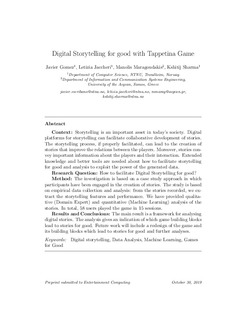| dc.contributor.author | Gomez Escribano, Javier | |
| dc.contributor.author | Jaccheri, Maria Letizia | |
| dc.contributor.author | Maragoudakis, Manolis | |
| dc.contributor.author | Sharma, Kshitij | |
| dc.date.accessioned | 2019-11-04T11:29:07Z | |
| dc.date.available | 2019-11-04T11:29:07Z | |
| dc.date.created | 2019-04-13T12:58:03Z | |
| dc.date.issued | 2019 | |
| dc.identifier.citation | Entertainment Computing. 2019, 30 1-9. | nb_NO |
| dc.identifier.issn | 1875-9521 | |
| dc.identifier.uri | http://hdl.handle.net/11250/2626356 | |
| dc.description.abstract | Context
Storytelling is an important asset in today’s society. Digital platforms for storytelling can facilitate collaborative development of stories. The storytelling process, if properly facilitated, can lead to the creation of stories that improve the relations between the players. Moreover, stories convey important information about the players and their interaction. Extended knowledge and better tools are needed about how to facilitate storytelling for good and analysis to exploit the power of the generated data.
Research question
How to facilitate Digital Storytelling for good?
Method
The investigation is based on a case study approach in which participants have been engaged in the creation of stories. The study is based on empirical data collection and analysis: from the stories recorded, we extract the storytelling features and performance. We have provided qualitative (Domain Expert) and quantitative (Machine Learning) analysis of the stories. In total, 58 users played the game in 15 sessions.
Results and conclusions
The main result is a framework for analysing digital stories. The analysis gives an indication of which game building blocks lead to stories for good. Future work will include a redesign of the game and its building blocks which lead to stories for good and further analyses. | nb_NO |
| dc.language.iso | eng | nb_NO |
| dc.publisher | Elsevier | nb_NO |
| dc.rights | Attribution-NonCommercial-NoDerivatives 4.0 Internasjonal | * |
| dc.rights.uri | http://creativecommons.org/licenses/by-nc-nd/4.0/deed.no | * |
| dc.title | Digital storytelling for good with Tappetina game | nb_NO |
| dc.type | Journal article | nb_NO |
| dc.type | Peer reviewed | nb_NO |
| dc.description.version | acceptedVersion | nb_NO |
| dc.source.pagenumber | 1-9 | nb_NO |
| dc.source.volume | 30 | nb_NO |
| dc.source.journal | Entertainment Computing | nb_NO |
| dc.identifier.doi | 10.1016/j.entcom.2019.100297 | |
| dc.identifier.cristin | 1692107 | |
| dc.description.localcode | © 2019. This is the authors’ accepted and refereed manuscript to the article. Locked until 19.3.2021 due to copyright restrictions. This manuscript version is made available under the CC-BY-NC-ND 4.0 license http://creativecommons.org/licenses/by-nc-nd/4.0/ | nb_NO |
| cristin.unitcode | 194,63,10,0 | |
| cristin.unitname | Institutt for datateknologi og informatikk | |
| cristin.ispublished | true | |
| cristin.fulltext | preprint | |
| cristin.qualitycode | 1 | |

